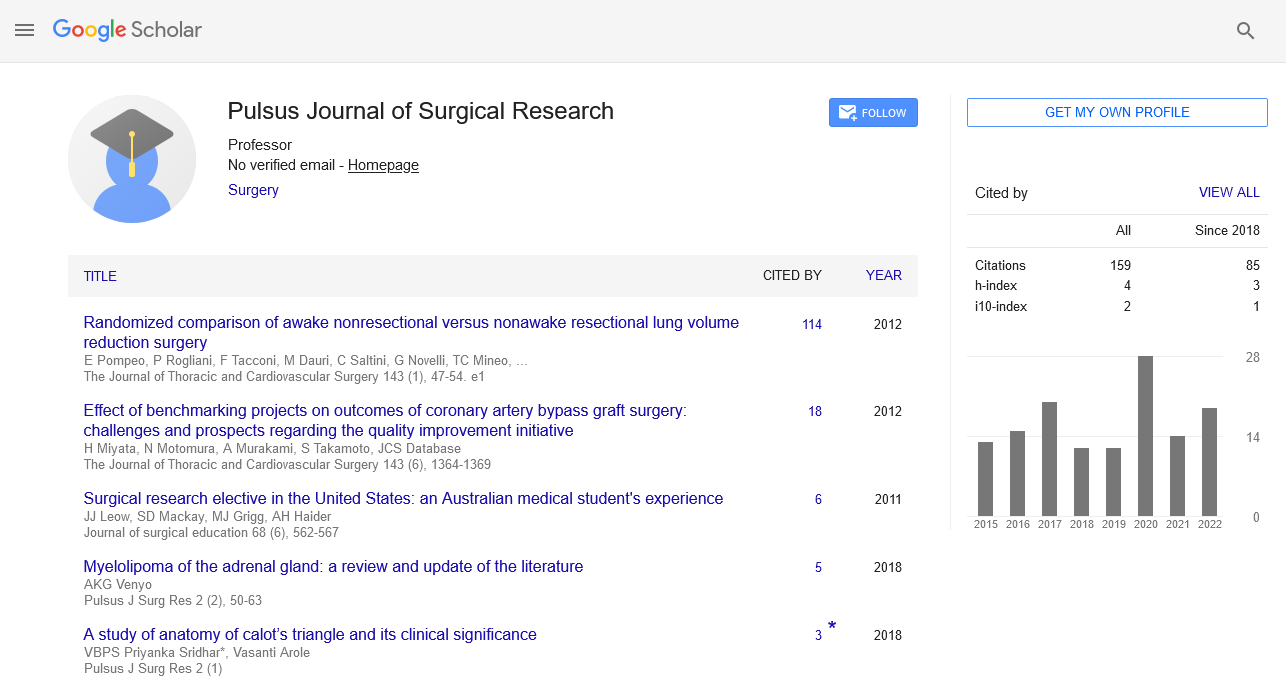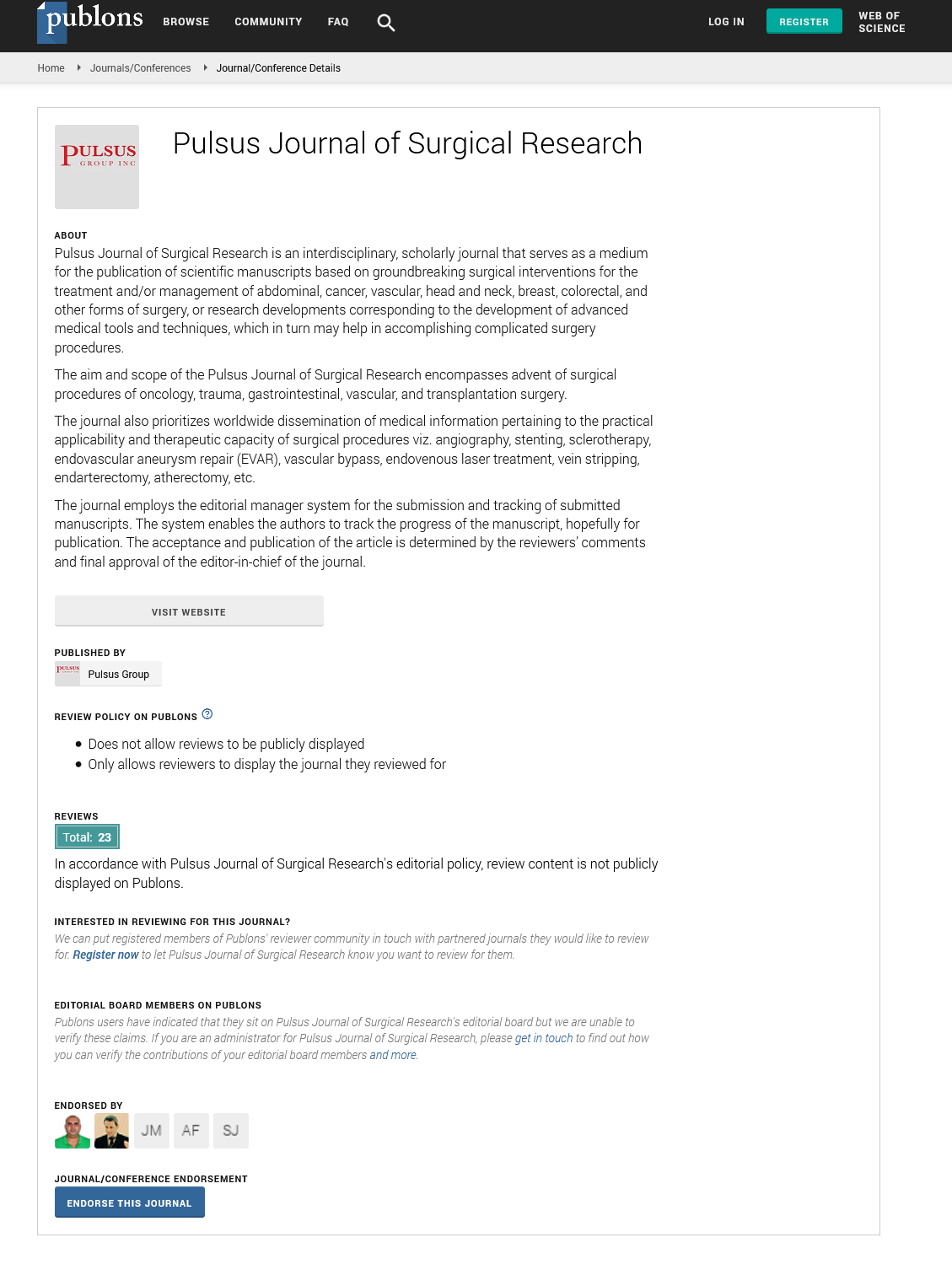Risk factors for operative site infection following pancreatic surgery
Received: 03-Aug-2022, Manuscript No. pulpjsr- 22-5747; Editor assigned: 06-Aug-2022, Pre QC No. pulpjsr- 22-5747 (PQ); Accepted Date: Aug 26, 2022; Reviewed: 18-Aug-2022 QC No. pulpjsr- 22-5747 (Q); Revised: 24-Aug-2022, Manuscript No. pulpjsr- 22-5747 (R); Published: 30-Aug-2022
Citation: Himanshi S . Risk factors for operative site infection following pancreatic surgery.J surg Res. 2022; 6(4):55-57.
This open-access article is distributed under the terms of the Creative Commons Attribution Non-Commercial License (CC BY-NC) (http://creativecommons.org/licenses/by-nc/4.0/), which permits reuse, distribution and reproduction of the article, provided that the original work is properly cited and the reuse is restricted to noncommercial purposes. For commercial reuse, contact reprints@pulsus.com
Abstract
Infection complications after pancreatic surgery are highly morbid, many facilities administer postoperative antibiotics to all patients. However, local customs influence how antibiotic regimens are prescribed. In order to more clearly characterize the clinical indications for this situation, the goals of this study were to describe the incidence of surgical site infection and prescription following pancreatic surgery as well as to identify the risk factors for these infections. Patients were saved from receiving unneeded antibiotic treatment as a result of non-routine after major pancreatic surgery. This raises the possibility that normal
prescriptions might be excessive, but additional research is required to validate such antibiotic management. The presence of a biliary prosthesis does not appear to be a meaningful clinical indicator for individual-based prescription, although fever does.
Key Words
Surgical care; Growth survival ; Larvae; Model construction
Introduction
The high frequency of problems following pancreatic surgery, several teams now regularly administer postoperative antibiotics after pancreaticoduodenectomy. The use of prophylactic antibiotics does not always have to be confined to the first postoperative day; some authors advise systematic longer-term antibiotic usage, particularly in high-risk patients or when pre-operative biliary drainage precedes surgery. In fact, preoperative bile duct drainage is linked to higher rates of mortality and infectious morbidity. This might be connected to more challenging bile duct dissection. However, frequent prescriptions put patients at risk for the establishment of multi-drug-resistant organisms or for serious adverse reactions to antibiotic treatments. The incidence of surgical site infections and common prescriptions following pancreatic surgery were described. To find people for whom routine prescriptions could be avoided, risk factors for surgical site infections were looked for. Significant morbidity and mortality have always been linked to pancreatic surgery. Despite this, there are more pancreatic procedures performed each year to remove malignant and premalignant lesions of the pancreas. Although the year survival rate for pancreatic cancer is still low, there will be a rise in the overall number of long-term survivors. In addition, it is anticipated that patients with benign neoplasms that have been removed would live normal lives. Due to this, patients' counseling regarding the effects of pancreatectomy must be prioritized. Patients should be well educated and have a thorough awareness of the long-term outcome and any potential changes in their health, in addition to the standard perioperative risks and consequences. Incisional hernia, endocrine, and exocrine insufficiency, anastomotic site ulcer, and bile duct and pancreatic duct strictures are a few examples of long-term consequences. These complications could lead to a variety of outcomes, including hospitalization, endoscopic and/or radiologic procedures, and additional surgeries. The majority of post-pancreatectomy literature, however, focuses on the initial months. It is crucial to look at the long-term health condition of pancreatectomy survivors and the difficulties they face that can be linked to their initial procedure. The current study's objective was to discover long-term problems among patients who had benign pancreatic surgery and survived for more than five years. Patients who were still living after a full recovery for more than five years were located and contacted over the phone. The study and survey were disclosed to those who could be reached. Patients who expressed interest received a letter of recruiting. Analgesia use, hospitalizations, additional operations, interventional procedures, dietary status, and diabetic status were all identified by the survey. After a few days or full recovery from their initial pancreatic surgery, agreed patients were specifically instructed to complete the survey by listing any difficulties, operations, and treatments. In order to validate and/or complement the patients' accounts, the electronic medical records of the patients were checked for preoperative baseline data, operation data, and long-term follow data. The nonparametric Wilcoxon rank-sum tests were used to compare continuous variables between groups. These variables were expressed as the median and interquartile range. The frequency and percentages of categorical variables were combined, and Pearson's Chi-squared or Fisher's exact tests were used to compare them. The outcome was statistically analyzed. Stata was used to perform each analysis Patients reported needing pancreatic enzyme replacement therapy at the time of the procedure, however, only one patient reported having PERT at the time of the operation. Due to the loss of exocrine function, pancreatic enzyme replacement medication was necessary for all patients who underwent total pancreatectomy. Patients who underwent pancreatoduodenectomies were more likely than those who underwent central pancreectomies to need pancreatic enzyme replacement therapy. There was no discernible difference between the various types of operations, with the exception of complete pancreatectomy. After completing a full recovery, reported a median of hospitalizations linked to their pancreatectomy, ranging from hospitalizations. Patients who received pancreatoduodenectomy saw considerably higher hospitalization rates than patients who underwent other procedures such as distal, central, or total pancreatectomy. The most frequent reason for hospitalization for people who had pancreatoduodenectomy surgery was pancreatitis, which was followed by small bowel obstruction, gastrointestinal bleeding, and cholangitis. Fewer patients who underwent central and distal pancreatectomy needed to be hospitalized. Hospitalization was necessary for individuals who underwent total pancreatectomy, and these patients all had issues with their glycemic management. One hospitalization for hyperglycemia and four hospitalizations for hypoglycemia.
Reported chronic use of analgesic drugs. One patient had a distal pancreatectomy, and five patients had pancreatoduodenectomies. The remainder of these individuals acknowledged using non-steroidal anti-inflammatory medicines, while the other half admitted to using opioids. Hepaticojejunostomy strictures were stented in patients who had undergone pancreatoduodenectomy and one total pancreatectomy. Additionally, pancreatoduodenectomy patients who had gastrojejunostomy and pancreatojejunostomy strictures got endoscopic balloon dilatation. There were individuals who reportedly needed additional abdominal surgeries as a result of their pancreatic urgery. Compared to patients who received other forms of pancreatectomy, patients who underwent pancreatoduodenectomy were considerably more likely to require additional abdominal surgeries. With a median wait time of 16.0 months between the main surgery and the repair, incisional hernia repair was the most common procedure across all types of pancreatectomy. There was no correlation between perioperative Clavien-Dindo grade problems and anastomotic strictures or incisional hernias. This study focused on problems impacted by pancreatic function and the type of pancreatectomy, and it looked at the health of patients a median number of years following pancreatic surgery. Previous research has only examined short-term postoperative results and has not questioned subsequent hospitalizations, treatments, or procedures after pancreatectomy recovery. Due to the fact that these procedures are being carried out more frequently and that patients are living longer, doctors and patients alike need to be aware of the long-term effects of these procedures. We were able to gain a better understanding of pancreas-related health by examining people who underwent various types of pancreatectomy for a variety of reasons. Unintentional weight loss, a new need for insulin, frequent hospital stays for digestive and glycemic control issues, and abdominal surgeries, including hernias, were among the reported long-term effects. Pre-operative data were used to compare weight reduction and diabetic medication usage, and hospital records were used to validate the bulk of self-reported interventions and operations.
Patients frequently express concern about their weight in clinics in the years following pancreas surgery. Current weights were in fact lower than national averages given by the National Center for Health Statistics when comparing weight by age and gender.
States who have been diagnosed with diabetes and use insulin. Diabetic individuals experienced retinal disease and neuropathy, respectively. Both the incidence of retinopathy and neuropathy were less common than previously reported. The majority of diabetes patients, or individuals, showed signs of microvascular problems. Hospital stays for a variety of conditions following full recovery from pancreatic surgery. Patients who received a whole pancreatectomy or pancreatoduode- economy saw increased hospitalization rates. The more profound anatomical and functional alterations brought on by these procedures may be to blame for this. Additionally, it should be highlighted that dysglycemia was a factor in every stay for patients who had total pancreatectomy. As a result, patients should be wellinformed about the dangers, carefully chosen for this procedure, and well-versed in glucose control both before and after a complete pancreatectomy. Patients who were long-term survivors needed an ERCP treatment at least once. The most common cause of was anastomotic stricture. Since a pancreatoduodenectomy only needs a few anastomoses, typically used on these patients? Hepaticojejunostomy and pancreatojejunostomy strictures have been observed to occur at rates of and. To our knowledge, no one has ever documented the frequency of this long following pancreatic surgery. This study's incidence of stent installation and balloon dilation, which is within the range of rates described in the literature, maybe a sign of stricture formation. Because endoscopic procedures are favored at our institution and operating is only used in the event of interventional failure, the high utilization in this series contrasts with the low rate of operative management. The self-reporting of retrospective occurrences constituted a significant study drawback. As a result, patients might not have remembered difficulties accurately or may have mistakenly linked hospitalizations and procedures to their pancreas operation. The online medical record and clinic notes were compared to the collected data about surgeries and hospitalizations in order to increase the quality of the data. The further instances that were reported took place outside of our healthcare system. For future investigations, it would be crucial to investigate the timing of occurrences, drugs used for ulcer prophylaxis, and radiologic interventional techniques like biliary drainage and percutaneous Trans hepatic cholangiography. The cohort size is smaller than expected, but given the outcomes of pancreatic cancer and the way this study was designed, data collection was challenging. In order to obtain their informed permission, patients should be educated about their long-term health conditions and complications. Over time, many people will lose weight unintentionally. One additional procedure may be necessary for one-third of patients who have a pancreatic operation. Pancreatoduodenectomy patients are more likely to need or experience structural problems because of their altered anatomy. The rates of several problems in this study were comparable to those postoperatively reported over months in earlier studies. It can be assumed that a large number of long-term effects of pancreatectomy happen within the first two years following surgery and do not accumulate over time. Additional confirmation is required for this significant finding. His research offers fresh understandings and recommendations for doctors teaching their patients about the long-term implications of pancreatic surgery. This is crucial because patients who are anticipated to have a normal life expectancy are undergoing preventativesurgeries.






